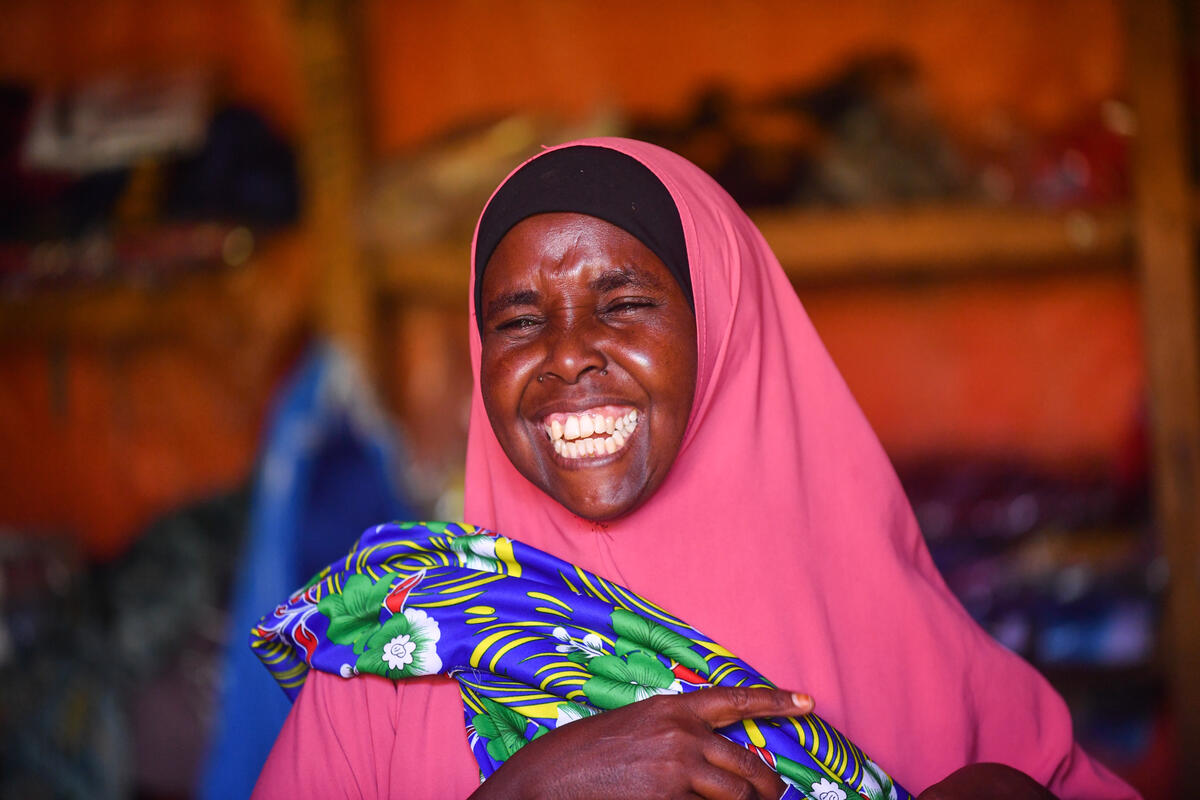Investing in Women and Girls Accelerates Progress for Millions
Investing in Women and Girls Accelerates Progress for Millions World Food Program USA


Investing in Gender Equality and Women’s Empowerment for Sustainable Development

Rome – Investing in gender equality and women’s empowerment is not only more urgent than ever but also an incredibly smart investment to generate economic growth, food security, income opportunities, and better lives, particularly in rural areas where most of the world’s poorest live. That will be the message tomorrow on International Women’s Day from leaders at the Rome-based United Nations agriculture and food agencies event, “Invest in Women: Accelerate Progress.”
Closing Gender Gaps for Sustainable Development
Closing gender gaps in farm productivity and wages within agrifood systems could boost the global domestic product by 1%, representing nearly $1 trillion, and decrease global food insecurity levels, leading to 45 million more people being food secure, according to the 2023 FAO status of women in agrifood systems report.
“Investing in women means investing in sustainable development. The return on investment isn’t just being able to beat poverty and inequality but building stronger institutions, economies, and entire communities,” said Gerardine Mukeshimana, vice-president of the International Fund for Agricultural Development (IFAD).
“Given women’s crucial role in rural economies and agrifood systems, particularly in low- and middle-income countries, addressing the gender gap in financing is critical for more inclusive and equitable rural development. Bridging this gap not only empowers women but can also have significant benefits for their households and communities,” said Maria Helena Semedo, deputy director-general, Food and Agriculture Organization of the United Nations (FAO).
“When we invest in women and girls, we nurture entire communities,” said Valerie Guarnieri, United Nations World Food Programme (WFP) assistant executive director, programme operations. “We can win the battle against hunger and malnutrition by empowering and supporting women to take the lead.”
The Funding Gap and Women’s Role in Agrifood Systems
Today, only 4% of total bilateral aid is dedicated to programs with gender equality as the principal objective, according to the Organisation for Economic Cooperation and Development (OECD) 2022 Gender snapshot. Furthermore, the existing funding gap to achieve gender equality in key areas, including reaching the Sustainable Development Goals to end hunger and poverty and supporting equal participation of women in societies by 2030, is about $360 billion annually in 48 developing countries (FAO 2023).
Agrifood systems are an important source of income for women in many countries. In Sub-Saharan Africa, for example, 66% of women’s employment is in agrifood systems, and in southern Asia, it is as much as 71%. Women are essential to global, regional, and national food security (FAO 2023).
Yet, women’s unequal status, due to discriminatory social norms present in society and agrifood systems, leaves them vulnerable to hunger and poverty. In 2022, 388 million women and girls lived in extreme poverty, and 27.8% of women were moderately or severely food insecure.
This overall picture of gender disparity is starkly evident in rural areas. Limited access to assets and agricultural inputs generates a land productivity gender gap, with a 24% difference between productivity from female versus male-managed farms of the same size. Women earn, on average, 18.4% less in wage employment in agriculture: When men earn one dollar, women earn about 82 cents. Also, heatwaves and floods affect rural women and men differently and widen the income gap, as highlighted in the Unjust Climate report (FAO 2024).
Call for Action to Address the Gender Gap
The Rome-based United Nations agriculture and food agencies call for strong political commitment and increased and accelerated investments in gender equality and women’s empowerment to improve food security, livelihoods, and economic and social well-being for all.
The solutions lie in investing in women’s and girls’ capacity through education, developing leadership skills, and by addressing discriminatory social norms that limit their opportunities. Strengthening land rights for women is also essential, as is ensuring women’s equal access to resources, including financial and extension services, to bridge productivity gaps.
In close collaboration with IFAD and WFP, FAO plans to launch a major global initiative to advance gender equality and women’s empowerment at the 68th session of the Commission on the Status of Women, which will take place from March 11 – 12, 2024, harnessing the momentum generated by the Committee on World Food Security (CFS) “Voluntary Guidelines on Gender Equality and Women’s and Girls’ Empowerment in Food Security and Nutrition” endorsed in 2023 and the 2023 FAO “Status of women in agrifood systems” report.
The Rome-based agencies are also spearheading gender-transformative approaches within agricultural and rural development projects, challenging gender norms and practices, power dynamics, and decision-making processes through the Joint Programme on Gender Transformative Approaches for Food Security, Improved Nutrition, and Sustainable Agriculture. With UN Women, the Rome-based agencies are also implementing the Joint Programme on Rural Women’s Economic Empowerment, a global initiative to secure rural women’s livelihoods, rights, and resilience.
Conclusion
Investing in gender equality and women’s empowerment is not only a moral imperative but also a strategic investment for sustainable development. By closing gender gaps in agrifood systems, we can boost economic growth, improve food security, and create better lives for millions of people. It is crucial to address the funding gap and discriminatory social norms that limit women’s opportunities. The Rome-based United Nations agriculture and food agencies are leading the way in promoting gender equality and women’s empowerment through various initiatives and programs. Together, we can achieve the Sustainable Development Goals and create a more inclusive and equitable world.
SDGs, Targets, and Indicators
-
SDG 1: No Poverty
- Target 1.1: By 2030, eradicate extreme poverty for all people everywhere
- Indicator: Percentage of population living below the international poverty line
-
SDG 2: Zero Hunger
- Target 2.1: By 2030, end hunger and ensure access by all people, in particular the poor and people in vulnerable situations, including infants, to safe, nutritious and sufficient food all year round
- Indicator: Prevalence of undernourishment
-
SDG 5: Gender Equality
- Target 5.1: End all forms of discrimination against all women and girls everywhere
- Indicator: Proportion of women and girls subjected to sexual violence by age
- Target 5.2: Eliminate all forms of violence against all women and girls in the public and private spheres, including trafficking and sexual and other types of exploitation
- Indicator: Proportion of ever-partnered women and girls subjected to physical, sexual or psychological violence by a current or former intimate partner in the previous 12 months
- Target 5.a: Undertake reforms to give women equal rights to economic resources, as well as access to ownership and control over land and other forms of property, financial services, inheritance and natural resources, in accordance with national laws
- Indicator: Proportion of women and girls aged 15 years and older subjected to sexual violence by persons other than an intimate partner in the previous 12 months
- Target 5.b: Enhance the use of enabling technology, in particular information and communications technology, to promote the empowerment of women
- Indicator: Proportion of individuals who own a mobile telephone, by sex
-
SDG 8: Decent Work and Economic Growth
- Target 8.5: By 2030, achieve full and productive employment and decent work for all women and men, including for young people and persons with disabilities, and equal pay for work of equal value
- Indicator: Employment-to-population ratio by sex, age group and persons with disabilities
-
SDG 10: Reduced Inequalities
- Target 10.2: By 2030, empower and promote the social, economic and political inclusion of all, irrespective of age, sex, disability, race, ethnicity, origin, religion or economic or other status
- Indicator: Proportion of people living below 50 percent of median income, by sex, age group and persons with disabilities
-
SDG 17: Partnerships for the Goals
- Target 17.17: Encourage and promote effective public, public-private and civil society partnerships, building on the experience and resourcing strategies of partnerships
- Indicator: Number of countries reporting progress in multi-stakeholder development effectiveness monitoring frameworks that support the achievement of the sustainable development goals
Analysis
1. Which SDGs are addressed or connected to the issues highlighted in the article?
The issues highlighted in the article are connected to the following SDGs:
– SDG 1: No Poverty
– SDG 2: Zero Hunger
– SDG 5: Gender Equality
– SDG 8: Decent Work and Economic Growth
– SDG 10: Reduced Inequalities
– SDG 17: Partnerships for the Goals
2. What specific targets under those SDGs can be identified based on the article’s content?
Based on the article’s content, the following specific targets can be identified:
– Target 1.1: Eradicate extreme poverty for all people everywhere
– Target 2.1: End hunger and ensure access to safe, nutritious, and sufficient food all year round
– Target 5.1: End all forms of discrimination against all women and girls everywhere
– Target 5.2: Eliminate all forms of violence against women and girls
– Target 5.a: Give women equal rights to economic resources and access to ownership and control over land and other forms of property
– Target 5.b: Enhance the use of enabling technology to promote the empowerment of women
– Target 8.5: Achieve full and productive employment and decent work for all women and men, including equal pay for work of equal value
– Target 10.2: Empower and promote the social, economic, and political inclusion of all, irrespective of age, sex, disability, race, ethnicity, origin, religion, or economic or other status
– Target 17.17: Encourage and promote effective public, public-private, and civil society partnerships
3. Are there any indicators mentioned or implied in the article that can be used to measure progress towards the identified targets?
Yes, there are indicators mentioned or implied in the article that can be used to measure progress towards the identified targets. These indicators include:
– Percentage of population living below the international poverty line (Target 1.1)
– Prevalence of undernourishment (Target 2.1)
– Proportion of women and girls subjected to sexual violence by age (Target 5.1)
– Proportion of ever-partnered women and girls subjected to violence by a current or former intimate partner (Target 5.2)
– Proportion of women and girls aged 15 years and older subjected to sexual violence by persons other than an intimate partner (Target 5.a)
– Proportion of individuals who own a mobile telephone, by sex (Target 5.b)
– Employment-to-population ratio by sex, age group, and persons with disabilities (Target 8.5)
– Proportion of people living below 50 percent of median income, by sex, age group, and persons with disabilities (Target 10.2)
– Number of countries reporting progress in multi-stakeholder development effectiveness monitoring frameworks (Target 17.17)
Table: SDGs, Targets, and Indicators
| SDGs | Targets
Behold! This splendid article springs forth from the wellspring of knowledge, shaped by a wondrous proprietary AI technology that delved into a vast ocean of data, illuminating the path towards the Sustainable Development Goals. Remember that all rights are reserved by SDG Investors LLC, empowering us to champion progress together. Source: wfpusa.org
Join us, as fellow seekers of change, on a transformative journey at https://sdgtalks.ai/welcome, where you can become a member and actively contribute to shaping a brighter future.
|
|---|








